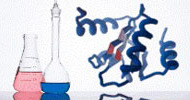
 Categories
Categories  Proteomics
Proteomics


Peptides are biological macromolecules composed of two or more amino acids linked by peptide bonds, exhibiting diverse biological functions. Tandem mass...

Mass spectrometry for identifying protein molecular weight requires minimal sample consumption and offers high sensitivity, resolution, and accuracy,...

Gangliosides are a large class of complex lipids that are abundant in the neuronal cell membranes in the brain. These molecules consist of sphingolipids with...

In animals, many dietary lipids are hydrolyzed into free fatty acids (FFAs) before absorption and subsequent lipid synthesis. Lipids undergo hydrolysis into...

Lipids play an important role in plants, serving as structural components of cell membranes, main storage substances in seeds, pigments for energy capture in...

As the main components of cell membranes and energy sources, lipids play a significant role in both cellular and physiological energy homeostasis. The...

Protein phosphorylation is a common post-translational modification in eukaryotes. Eukaryotic cell protein phosphorylation is divided into two types: serine...

Chemical proteomics, as an important branch of proteomics, integrates methods from synthetic chemistry, cell biology, and mass spectrometry. It aims to...

The immunopeptidome comprises all short peptides presented on the cell surface by HLA-I and II molecules for T-cell recognition. Immunopeptidomics analysis...

Immunoprecipitation (IP) technology is a method widely used in antigen purification and detection, which separates specific proteins from a solution by...

Parallel Reaction Monitoring (PRM) is an ion monitoring technology based on high-resolution and high-precision mass spectrometry. The principle of PRM...

Tandem mass tags, TMT technology is a tandem mass spectrometry labeling technology developed by Thermo Company, mainly used for the identification and...

In top-down proteomics analysis, intact protein molecular ions generated by ESI or MALDI are introduced into a mass analyzer and undergo gas-phase...

Polyunsaturated fatty acids (PUFAs) are primarily classified into ?-3 and ?-6 fatty acids. The difference between these two fatty acids lies in the position...

The health benefits of olive oil are well-documented, and it is widely believed that phenolic compounds found in olive oil contribute to some of these...

NAD metabolism-related small molecules include oxidized nicotinamide adenine dinucleotide (NAD+), reduced nicotinamide adenine dinucleotide (NADH), oxidized...

Mycolic acids (MAs) are distinctive markers of the cell envelope in Mycobacterium tuberculosis and related species. Their unique and complex structures can...

Lipoxygenase is a family of non-heme, iron-containing enzymes. Most of these enzymes catalyze the dioxygenation of polyunsaturated fatty acids with...

Leukotrienes (LTs) are a group of inflammatory lipid mediators derived from arachidonic acid (AA) via the 5-lipoxygenase (5-LOX) pathway. A characteristic...

MtoZ Biolabs operates a leading-edge platform for peptide synthesis, equipped with several automated multi-channel peptide synthesizers, high-performance...